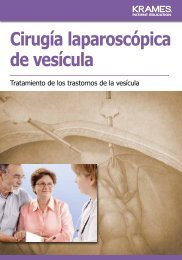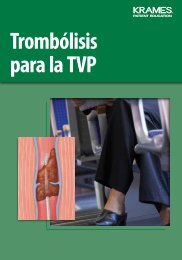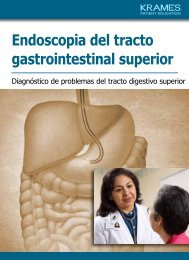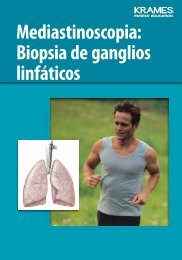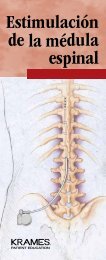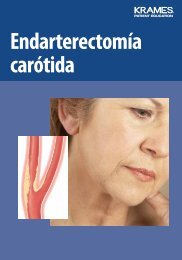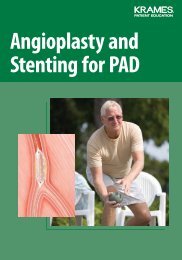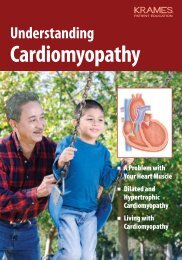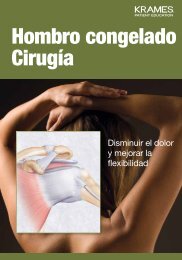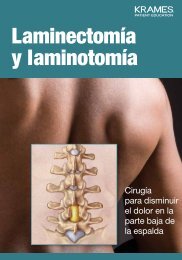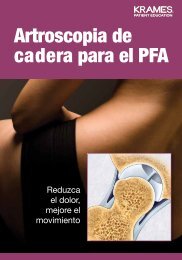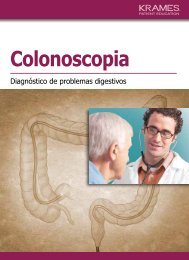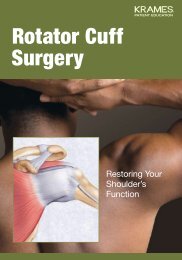Carotid Angioplasty and Stenting - Veterans Health Library
Carotid Angioplasty and Stenting - Veterans Health Library
Carotid Angioplasty and Stenting - Veterans Health Library
Create successful ePaper yourself
Turn your PDF publications into a flip-book with our unique Google optimized e-Paper software.
<strong>Carotid</strong> <strong>Angioplasty</strong><br />
<strong>and</strong> <strong>Stenting</strong>
Your <strong>Carotid</strong> Artery Problem<br />
The carotid arteries are blood vessels in the neck that carry<br />
blood to the brain. One or both of your carotids is narrowed<br />
due to a buildup of plaque, a fatty material that sticks to artery<br />
walls. Narrowing can reduce the brain’s blood supply <strong>and</strong><br />
increase the risk of a stroke (loss of brain function due to death<br />
of brain tissue). A device called a stent can be put in place to<br />
hold the artery open <strong>and</strong> reduce stroke risk.<br />
Are You At Risk of a Stroke?<br />
Plaque in the carotid arteries increases your risk of stroke. Other risk<br />
factors include high blood pressure, high cholesterol levels, smoking,<br />
diabetes, <strong>and</strong> having heart disease or other types of vascular (blood<br />
vessel) disease. A stroke is a serious problem. It can cause severe disability,<br />
including difficulty with speaking, walking, <strong>and</strong> doing the simplest tasks.<br />
And a stroke can be deadly. This is why your doctor is suggesting treatment<br />
to lower your risk.<br />
Symptoms of a Stroke<br />
Below are symptoms of a stroke.<br />
The longer you delay getting<br />
treatment, the more damage a<br />
stroke can do. Call 911 right<br />
away if you have any of<br />
these symptoms:<br />
■ Paralysis or weakness on one<br />
side of the body<br />
■ Numbness or tingling on one<br />
side of the body<br />
■ Difficulty speaking<br />
■ Loss of vision in one eye<br />
■ Drooping on one side of the face<br />
Sudden weakness<br />
on one side of the<br />
body can be a sign<br />
of stroke.<br />
2
How <strong>Carotid</strong> Artery <strong>Stenting</strong> Can Help<br />
If your doctor suspects narrowing of the carotid artery, you’ll<br />
have tests to assess your need for treatment. Surgery to remove<br />
plaque (endarterectomy) is often used to correct the problem.<br />
<strong>Stenting</strong> is a new alternative to endarterectomy that is a better<br />
option for some people. A stent is a metal mesh tube that’s<br />
inserted into the artery, helping to hold the artery open. This<br />
improves blood flow. <strong>Stenting</strong> uses a small<br />
puncture instead of an incision, so it’s<br />
called a “minimally invasive” or<br />
endovascular procedure.<br />
3
How a Stroke Can Occur<br />
Blood carries oxygen <strong>and</strong> nutrients to wherever they’re needed in the<br />
body. The brain needs a steady supply of blood to work. Problems<br />
with the vessels that supply blood to the brain can block blood flow.<br />
If this happens, parts of the brain can become starved of oxygen <strong>and</strong><br />
nutrients. This damages the affected area of the brain, which can<br />
impair certain body functions.<br />
Brain<br />
Internal<br />
carotid<br />
artery<br />
External<br />
carotid<br />
artery<br />
Internal<br />
carotid<br />
artery<br />
Blood<br />
flows to<br />
brain<br />
External<br />
carotid<br />
artery<br />
Common<br />
carotid<br />
artery<br />
From the Heart to the Brain<br />
The heart pumps blood throughout the<br />
body. Blood vessels called arteries carry<br />
blood to the limbs <strong>and</strong> to the organs,<br />
including the brain. The carotid arteries<br />
are two of the main pathways for blood<br />
traveling to the brain. There are two<br />
common carotid arteries, each traveling<br />
up one side of the neck. Each artery<br />
divides into two branches. The internal<br />
carotid artery carries blood into the brain,<br />
<strong>and</strong> the external carotid artery supplies<br />
blood to the face <strong>and</strong> scalp.<br />
Common<br />
carotid<br />
artery<br />
A healthy carotid artery lets blood flow<br />
easily to the brain.<br />
<strong>Health</strong>y <strong>Carotid</strong> Arteries<br />
When carotid arteries are healthy, the<br />
artery walls are smooth. The arteries<br />
are open, allowing blood to flow freely<br />
to the brain. The brain gets all the blood<br />
it needs to function well.<br />
4
Narrowed <strong>Carotid</strong> Arteries<br />
Arteries can become damaged due to risk<br />
factors such as smoking, diabetes, <strong>and</strong><br />
high blood pressure. Heredity (family<br />
history) also makes some people more<br />
prone to artery damage. A damaged artery<br />
no longer has a smooth lining. Cholesterol<br />
<strong>and</strong> other particles in the blood stick to<br />
the artery wall <strong>and</strong> form plaque. A buildup<br />
of plaque leads to stenosis (narrowing<br />
of the artery). This can reduce blood flow.<br />
How Plaque Causes Blockage<br />
The surface of plaque may be rough.<br />
Blood can collect there <strong>and</strong> form clots.<br />
Also, plaque can rupture, causing pieces<br />
to break off <strong>and</strong> enter the bloodstream.<br />
At the same time, rupture can produce<br />
more blood clots. Fragments of plaque<br />
<strong>and</strong> tiny blood clots (emboli) then travel<br />
to <strong>and</strong> block smaller arteries in the brain.<br />
This cuts off blood flow to a portion of<br />
the brain, resulting in a stroke.<br />
Emboli<br />
Damaged<br />
area<br />
Plaque<br />
Narrowed<br />
artery<br />
Blood<br />
clot<br />
Problems with blood flow can occur<br />
when an artery is narrowed by plaque.<br />
Emboli can enter the<br />
bloodstream <strong>and</strong> travel<br />
to the brain.<br />
Brain tissue is damaged<br />
when emboli block<br />
arteries in the brain.<br />
How a Stroke Affects You<br />
When blood flow is cut off, brain tissue<br />
can die, causing loss of brain function.<br />
This results in problems such as difficulty<br />
speaking or controlling movements. The<br />
exact symptoms depend on which part<br />
of the brain is affected. Symptoms often<br />
occur on one side of the body only, the<br />
side opposite the blockage. A stroke does<br />
permanent damage that can cause longlasting<br />
loss of function.<br />
What Is a TIA?<br />
A TIA (transient ischemic attack) is a<br />
temporary episode of stroke-like symptoms.<br />
It is sometimes called a “mini-stroke.”<br />
Having a TIA is a warning that you’re at<br />
high risk of a stroke. TIA symptoms go away<br />
within 24 hours, but otherwise they are<br />
exactly the same as stroke symptoms. If<br />
you have stroke symptoms, don’t waste time<br />
wondering whether you’re having a TIA:<br />
Call 911 right away!<br />
5
Your Medical Evaluation<br />
Is your carotid artery problem severe enough to need treatment?<br />
And is stenting the right treatment for you? An evaluation can<br />
give your doctor the information needed to make these decisions.<br />
This evaluation includes a medical history, an exam, <strong>and</strong> one or<br />
more imaging tests.<br />
Medical History<br />
Your doctor will ask whether you’ve had symptoms of a TIA or stroke.<br />
These include numbness, weakness, <strong>and</strong> vision changes. You’ll also be<br />
asked about factors that affect your vascular health, such as smoking <strong>and</strong><br />
high blood pressure. You’ll describe any current health problems, such as<br />
heart disease, kidney disease, <strong>and</strong> lung disease. And you’ll be asked about<br />
previous treatments <strong>and</strong> surgeries for artery problems.<br />
Physical Exam<br />
During your physical exam, your doctor will check your blood<br />
pressure <strong>and</strong> your pulse. He or she will also listen for the<br />
sound blood may make when it travels through a narrowed<br />
carotid artery. This sound is called a bruit (pronounced<br />
“broo-ee”). It is possible to have stenosis without having<br />
a bruit. The blood vessels in your eyes may also be<br />
checked for small emboli that can indicate<br />
carotid artery problems. Your doctor<br />
may then look for the effects of a past<br />
stroke. This includes checking<br />
reflexes, strength, vision or<br />
other senses, <strong>and</strong> the ability to<br />
underst<strong>and</strong> <strong>and</strong> use language.<br />
Your doctor will use a<br />
stethoscope to listen<br />
for signs of narrowing<br />
in your carotid arteries.<br />
6
Duplex Ultrasonography<br />
Duplex ultrasonography (ultrasound)<br />
is a noninvasive test. A scanner uses<br />
harmless sound waves to create images.<br />
A gel applied to the neck helps the<br />
scanner collect sound waves. The test<br />
checks for narrowing in the carotid<br />
arteries <strong>and</strong> estimates how severe<br />
it is. Duplex ultrasound also shows<br />
how blood flow through the arteries<br />
is affected. The results can indicate<br />
whether an artery needs treatment.<br />
Other Imaging Tests<br />
These tests may be used to check the brain for signs of a stroke. They may<br />
also be used to take pictures of the arteries.<br />
■ CT (computed tomography): A series of x-rays is taken with a special<br />
x-ray machine. Computers use these x-rays to create three-dimensional<br />
images. For CT angiography (CTA), contrast fluid (“x-ray dye”) may be<br />
injected to help arteries show up clearly on the x-ray.<br />
■ MRI (magnetic resonance imaging): This test uses a strong magnet to<br />
create detailed images of the body. A contrast fluid may be injected to<br />
highlight the arteries. It is different from the contrast fluid used for CTA.<br />
Angiography<br />
This test provides information<br />
needed to make decisions about<br />
treatment <strong>and</strong> to plan the procedure.<br />
Angiography may be done around<br />
the same time as other imaging tests.<br />
Or it may be done just before the<br />
stent is placed. For angiography:<br />
■ A catheter is inserted into an<br />
artery in the groin.<br />
■ Contrast fluid is injected through<br />
the catheter into the artery.<br />
■ X-ray images (angiograms) of the<br />
carotid are taken. Angiograms of<br />
arteries in the groin <strong>and</strong> torso may<br />
also be taken.<br />
Angiogram of a healthy<br />
carotid artery.<br />
Narrowed<br />
artery<br />
Angiogram of a carotid<br />
artery with stenosis.<br />
7
Preparing for <strong>Carotid</strong> Artery <strong>Stenting</strong><br />
You will be told how best to prepare for your procedure. This often<br />
includes stopping certain medications <strong>and</strong> starting others. Be sure<br />
to follow your doctor’s instructions. If you’ve had an angiogram<br />
before, many of these preparations will be familiar.<br />
A Week or More Beforeh<strong>and</strong><br />
Before stenting is done, you may talk to <strong>and</strong> be examined by one or more<br />
specialists. Before the procedure, be sure to:<br />
■ Tell your doctor if you have any allergies to foods or medications.<br />
■ Tell your doctor about any medications you take. This includes<br />
over-the-counter medications, herbs, <strong>and</strong> supplements.<br />
■ Make medication changes as directed by your doctor. You will take<br />
one or more medications to help prevent blood clots from forming<br />
in arteries. These antiplatelet medications may include aspirin <strong>and</strong><br />
prescription medication.<br />
You’ll prepare for<br />
the procedure by<br />
taking antiplatelet<br />
medication.<br />
8<br />
The Day Before the Procedure<br />
Before you have your stenting procedure, be sure that you:<br />
■ Pack for an overnight stay in the hospital.<br />
■ Arrange for a ride to <strong>and</strong> from the hospital.<br />
■ Don’t eat or drink after midnight, the night before the<br />
procedure. (Ask your doctor which medications to<br />
take during this period. Take them with a sip of water.)<br />
■ Follow any other instructions from your doctor.
On the Day of the Procedure<br />
When you arrive at the hospital, the staff will prepare you for the<br />
procedure. First you’ll change into a hospital gown. An area around<br />
your groin may then be prepared. An IV (intravenous) line will be<br />
started to provide you with fluids <strong>and</strong> medications. You will then be<br />
taken to the cath (catheterization) lab or angiography suite. This is a<br />
room that has all the equipment needed to perform the procedure.<br />
Risks <strong>and</strong> Complications<br />
Risks of carotid artery stenting include:<br />
■ Stroke<br />
■ Bleeding at puncture site<br />
■ Hypotension (low blood pressure)<br />
■ Thrombosis (blood clot) in the<br />
treated vessel<br />
■ Reaction to contrast fluid<br />
During the procedure<br />
you’ll be covered with<br />
sterile drapes to protect<br />
you from infection.<br />
■ Cardiac arrhythmias (heart<br />
rhythm problems)<br />
■ Need for retreatment<br />
■ Worsening of kidney function<br />
■ Heart attack<br />
■ Death<br />
9
The Procedure<br />
During the procedure, a long thin tube called a catheter is inserted<br />
into the artery. This is used to move instruments through the artery<br />
to put the stent in place. Working in the area can disturb plaque<br />
<strong>and</strong> cause pieces to break off. So, steps are taken to be sure these<br />
emboli don’t flow into the brain. Your doctor will need to talk to<br />
you during the procedure, so you’ll be awake the entire time.<br />
Inserting the Catheter<br />
To insert the catheter <strong>and</strong> prepare for stenting:<br />
■ The skin in the area of the insertion site is numbed<br />
with local anesthetic. A puncture is made in the<br />
femoral artery, a major artery in the groin.<br />
■ An introducing sheath (tube) is inserted into the<br />
puncture. The sheath remains in place throughout<br />
the procedure.<br />
■ The catheter is inserted into the sheath. Using<br />
x-rays as a guide, the doctor<br />
moves the catheter up<br />
the aorta, behind the<br />
Brain<br />
heart, <strong>and</strong> to the<br />
carotid.<br />
■ An angiogram of the<br />
carotid artery is taken.<br />
Heart<br />
Aorta<br />
Femoral<br />
artery<br />
Groin<br />
insertion<br />
site<br />
Catheter<br />
Internal<br />
carotid<br />
artery<br />
Filter<br />
Placing the Filter<br />
A filter or other protective device<br />
catches fragments of plaque that<br />
may break off. This prevents them<br />
from flowing into the brain <strong>and</strong><br />
causing a stroke. The catheter<br />
is used to place the unopened<br />
filter in the artery <strong>and</strong> advance<br />
it past the narrowed area. The<br />
filter is then opened. It remains<br />
in place for the whole procedure.<br />
If narrowing is very severe, the<br />
artery may need to be widened<br />
before the filter is put in place.<br />
10
The Stent: A Closer Look<br />
A carotid artery stent is a flexible wire mesh tube. It may<br />
be all one width, or it may be wider at one end. Once it’s<br />
placed in the artery, it remains there for life. The stent is<br />
resistant to pressures <strong>and</strong> crushing, so it adjusts easily<br />
when you move your head <strong>and</strong> neck. The stent fits snugly<br />
in the artery so it won’t slip out of place.<br />
Before<br />
placement<br />
After<br />
expansion<br />
Balloon<br />
Stent<br />
being<br />
released<br />
Filter<br />
removed<br />
Opening the Artery<br />
As part of placing the stent,<br />
the narrowed artery needs<br />
to be exp<strong>and</strong>ed. This is done<br />
using balloon angioplasty.<br />
A tiny, uninflated balloon is<br />
first moved to the area that<br />
needs to be widened. The<br />
balloon is then inflated,<br />
opening the artery. Afterward,<br />
it is deflated <strong>and</strong> removed.<br />
Placing the Stent<br />
The stent is moved to the<br />
site of the plaque. The<br />
catheter is then withdrawn,<br />
leaving the stent in place.<br />
The stent exp<strong>and</strong>s until<br />
it touches the plaque.<br />
Balloon angioplasty is then<br />
used to exp<strong>and</strong> the stent<br />
fully <strong>and</strong> widen the artery.<br />
The balloon is withdrawn,<br />
leaving the stent in place<br />
to hold the artery open.<br />
Checking the Result<br />
An angiogram is taken <strong>and</strong><br />
compared to the one that<br />
was taken at the beginning<br />
of the procedure. This is<br />
to check on the success of<br />
the procedure. Once your<br />
doctor is satisfied with the<br />
result, the filter <strong>and</strong> other<br />
instruments are withdrawn.<br />
The groin insertion site is<br />
then closed.<br />
11
After the Procedure<br />
After carotid artery stenting, you will most likely stay overnight<br />
in the hospital for care <strong>and</strong> monitoring. At home, follow your<br />
doctor’s instructions for recovery. Be sure to keep your medical<br />
appointments. Seeing your doctor for imaging tests <strong>and</strong> other<br />
follow-up treatment helps make the procedure a success.<br />
Just After the Procedure<br />
The sheath in your groin is removed,<br />
<strong>and</strong> the insertion site closed. This may<br />
be done while you’re still in the lab<br />
where the procedure took place. Or it<br />
may be done after you’ve been moved<br />
to a regular hospital room. A nurse may<br />
apply pressure to the site for several<br />
minutes. Depending on the type of<br />
closure, you may need to keep your<br />
leg straight for 2 to 6 hours.<br />
Your Hospital Stay<br />
You’ll be closely monitored until you’re<br />
ready to go home. Hospital staff will<br />
check your pulse <strong>and</strong> blood pressure<br />
from time to time. You may also have<br />
certain tests, such as tests of your brain<br />
function, blood tests, or an ultrasound.<br />
Your IV will remain in place until<br />
shortly before you go home.<br />
Going Home<br />
You can leave the hospital<br />
when:<br />
■ Your condition is stable.<br />
■ The groin insertion site<br />
is not bleeding.<br />
■ You have no signs of<br />
infection.<br />
■ Your doctor has reviewed<br />
any test results <strong>and</strong> has<br />
cleared you to go home.<br />
12<br />
You’ll likely go home the day after the<br />
procedure. An adult family member or<br />
friend should take you home.
Recovering at Home<br />
When you get home:<br />
■ Take prescribed antiplatelet medications<br />
as directed. This is needed to prevent<br />
blood clots from forming on the stent.<br />
It is normal for these medications to<br />
cause you to bruise more easily.<br />
■ Shower instead of taking tub baths<br />
for a few days.<br />
■ Avoid lifting anything over 10 pounds<br />
for a few days.<br />
■ Take it easy, but get back to your<br />
normal routine as much as possible.<br />
■ Follow your doctor’s instructions<br />
about driving, returning to work, <strong>and</strong><br />
other activities.<br />
When to Call Your Doctor<br />
Call 911 if you have any stroke<br />
symptoms.<br />
Call your doctor if you have any of<br />
the following problems (or go to<br />
the emergency room if your doctor’s<br />
office is closed):<br />
■ Problems at the incision site,<br />
such as swelling, redness,<br />
bleeding, warmth, leaking of<br />
fluids, or increasing pain<br />
■ A cold or painful leg or foot<br />
■ Severe headache<br />
Your Follow-Up<br />
Within a month after the procedure,<br />
you’ll have a follow-up exam <strong>and</strong><br />
tests. These tests may include an<br />
ultrasound <strong>and</strong> a brain function<br />
exam. Then you’ll be monitored with<br />
ultrasound or another imaging test<br />
every 6 months for 1 to 2 years. After<br />
that, you’ll be monitored at least every<br />
12 months. You may also continue to<br />
take antiplatelet medication. In rare<br />
cases, the carotid can narrow again.<br />
If this happens, it can often be treated<br />
again with balloon angioplasty.<br />
Keeping appointments for<br />
follow-up care helps make<br />
the procedure a success.<br />
13
Taking Control of Your <strong>Health</strong><br />
There’s a lot you can do to improve your health. To help make<br />
your stenting procedure a success, take medication as prescribed.<br />
If you smoke, quit—this can reduce your future risk of stroke<br />
or heart attack. And manage conditions such as high blood<br />
pressure, diabetes, <strong>and</strong> cholesterol problems by exercising <strong>and</strong><br />
eating healthier. The tips on these pages can help you get started.<br />
Taking Medication<br />
After the stenting procedure, you’ll need to take antiplatelet medication.<br />
You may also need to take medication to control cholesterol, diabetes, <strong>and</strong><br />
other artery disease risk factors. To get the most benefit from medications:<br />
■ Make sure you know when <strong>and</strong> how to take your medications,<br />
<strong>and</strong> what to do if you miss a dose.<br />
■ Develop a routine so you don’t miss doses. A pillbox with days<br />
of the week or hours of the day can help you keep track.<br />
■ Tell your doctor if you have any side effects.<br />
■ Don’t stop taking your medication or make any other changes<br />
without first talking to your doctor.<br />
Quitting Smoking<br />
Smoking damages blood vessels. It also makes blood clots more likely<br />
to form. If you smoke, quitting is one of the best things you can do to<br />
protect your health. To get started:<br />
■ Get medical help. Your healthcare<br />
provider may prescribe medications<br />
or other aids to help you quit.<br />
■ Get support. Ask your healthcare<br />
provider about local stop-smoking<br />
programs or support groups.<br />
Explain to your family <strong>and</strong> friends<br />
why you’re quitting, <strong>and</strong> ask for<br />
their help.<br />
■ Avoid temptations to smoke. Stay<br />
away from places <strong>and</strong> activities that<br />
make you want to light up.<br />
■ Don’t give up. Sometimes it takes<br />
more than one try to quit for good.<br />
Your healthcare provider may advise using nicotine<br />
replacement products to help you quit smoking.<br />
14
<strong>Health</strong>y Eating<br />
For healthier eating:<br />
■ Build more meals around plant-based<br />
foods. Good choices include vegetables,<br />
fruits, whole grains, <strong>and</strong> beans.<br />
■ Switch to lower-fat dairy products.<br />
For example, if you normally use whole<br />
milk, try reduced fat or fat free instead.<br />
■ Avoid fatty meats. Choose fish, poultry,<br />
<strong>and</strong> leaner cuts of meat instead.<br />
■ Choose fresh or plain frozen foods.<br />
Mixes <strong>and</strong> packaged foods are often<br />
high in sodium <strong>and</strong> unhealthy fats.<br />
Being Active<br />
Daily activity can be fun <strong>and</strong> can help<br />
you feel better. To get started:<br />
■ Talk to your doctor before starting<br />
an exercise program.<br />
■ Increase your activity level gradually.<br />
Work up to 30 minutes of walking or<br />
other exercise most days of the week.<br />
■ Be more active in small ways each<br />
day. For example, walk to see a friend<br />
instead of driving. Or do some of your<br />
err<strong>and</strong>s on foot.<br />
Gardening <strong>and</strong> other<br />
tasks can be part of<br />
being more active.<br />
Tips for Making Lifestyle Changes<br />
Making changes can seem overwhelming. So take things one step at a time:<br />
■ Work with your doctor to set goals for improving your health.<br />
■ Write down two or three things you can do to meet each goal.<br />
■ When you meet a goal, reward yourself. Then think about a new goal.<br />
■ Be positive. You don’t have to be perfect. If you slip up, try again. Don’t<br />
let a slip become an excuse for giving up.<br />
15
Taking Care of Your Vascular <strong>Health</strong><br />
A carotid artery stent can reduce your risk of having a stroke.<br />
But it doesn’t treat the artery disease that caused the problem<br />
in the first place. So you should take steps to improve your<br />
vascular health. The following resources can help you<br />
learn more.<br />
This product is not intended as a substitute for professional medical care.<br />
Only your doctor can diagnose <strong>and</strong> treat a medical problem.<br />
2211634 ©2010 The StayWell Company. www.krames.com 800-333-3032 All rights reserved.<br />
0909




